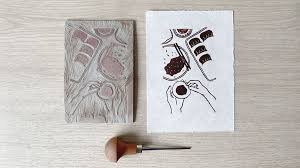Introduction
Lino printing, or linocut, is a revered printmaking technique known for its bold, graphic style and accessibility. Emerging in the early 20th century, it has become a staple in the art world, celebrated for its simplicity and expressive potential. This article delves into the history, materials, techniques, and contemporary relevance of lino printing, exploring why it continues to captivate artists and art enthusiasts alike.
Essential Materials
Lino printing is accessible with a few essential materials and tools:
- Linoleum Blocks: The foundation of lino printing, these blocks are typically made from a mixture of linseed oil and cork dust, providing a smooth, resilient surface. Linoleum is available in different thicknesses and sizes, with thicker blocks offering greater durability for multiple prints.
- Carving Tools: Specially designed for linoleum, these tools come in various shapes and sizes, including V-gouges, U-gouges, and chisels. Each tool is used to carve different line types and textures, allowing for intricate detailing and bold, sweeping curves.
- Printing Ink: Printmaking ink, available in oil-based and water-based varieties, is applied to the linoleum block using a brayer. Oil-based inks are preferred for their rich colors and durability, while water-based inks are easier to clean and environmentally friendly.
- Brayer (Roller): A rubber roller used to apply ink evenly to the carved linoleum surface. The brayer ensures that the ink is spread uniformly, creating a consistent layer on the block.
- Paper: High-quality, absorbent paper is crucial for capturing the fine details of the print. Popular choices include heavyweight printmaking papers, such as Somerset, Fabriano, or Japanese rice paper.
- Printing Press or Baren: A printing press provides consistent pressure for transferring the ink from the block to the paper. For hand-printing, a baren, a flat, circular tool, is used to rub the back of the paper, ensuring even pressure across the block.
Step-by-Step Guide to Creating a Linocut
- Design Creation: Start with a sketch of your design on paper. Once finalized, transfer the design onto the linoleum block using carbon paper or by drawing directly onto the block with a pencil. Ensure the design is in reverse, as the print will be a mirror image of the original.
- Carving the Design: Using your carving tools, begin to cut away the areas of the linoleum that will remain white in the final print. Work carefully, applying steady pressure to create clean, precise lines. Start with larger tools for broad areas and switch to finer tools for detailed work. Remember, the areas you carve away will be the white parts of your print, so keep track of your design’s composition.
- Inking the Block: Roll a thin layer of ink onto the linoleum block using a brayer. Apply the ink evenly, ensuring all raised surfaces are covered. Avoid over-inking, as it can lead to smudging and loss of detail. Roll the brayer over the block until a consistent, smooth layer of ink is achieved.
- Printing the Image: Place your paper on top of the inked linoleum block. If using a printing press, carefully position the paper over the block and adjust the press settings to apply even pressure. For hand-printing, place the paper on the block and use a baren to rub the back of the paper, applying firm, even pressure. Ensure the entire surface of the paper makes contact with the block to achieve a clear, crisp print.
- Drying and Finishing: Carefully peel the paper away from the block to reveal your print. Allow the print to dry completely, which may take several hours or overnight, depending on the ink used. Once dry, your print is ready for framing, display, or further artistic exploration.
Contemporary Trends and Applications
Lino Printing in Modern Art
Today, lino printing continues to thrive in contemporary art. Many artists use the medium to explore social, political, and personal themes, leveraging its expressive potential to create compelling, thought-provoking works. Lino printing’s simplicity and directness make it an ideal medium for conveying strong messages and emotions.
Educational Value and Community Engagement
Lino printing is a popular choice in art education, valued for its straightforward process and the foundational skills it teaches. It introduces students to essential printmaking techniques, including design development, carving, inking, and printing. Workshops and community art projects often feature lino printing, bringing people together to create and share their artistic expressions.
Lino Printing in Commercial Design
Beyond fine art, lino printing has found its place in commercial design and illustration. Its distinctive style is used in book illustrations, posters, textiles, and stationery, bringing a handcrafted, artisanal quality to various products. The unique texture and bold lines of lino prints continue to inspire designers and brands seeking a distinctive, handmade aesthetic.
Also Read : VyvyManga
Conclusion
Lino printing remains a vibrant and dynamic art form, celebrated for its simplicity, expressive potential, and versatility. From its humble beginnings as a floor covering to its status as a cornerstone of modern printmaking, lino printing continues to inspire and challenge artists worldwide. Its rich history, combined with its contemporary relevance, ensures that lino printing will remain a beloved and enduring medium for generations to come. Whether you are a seasoned artist or a curious beginner, lino printing offers a rewarding journey of creativity, discovery, and artistic expression. So, grab your tools, carve your design, and experience the timeless beauty of lino printing for yourself.
